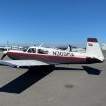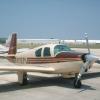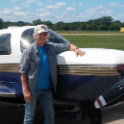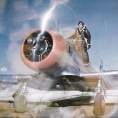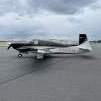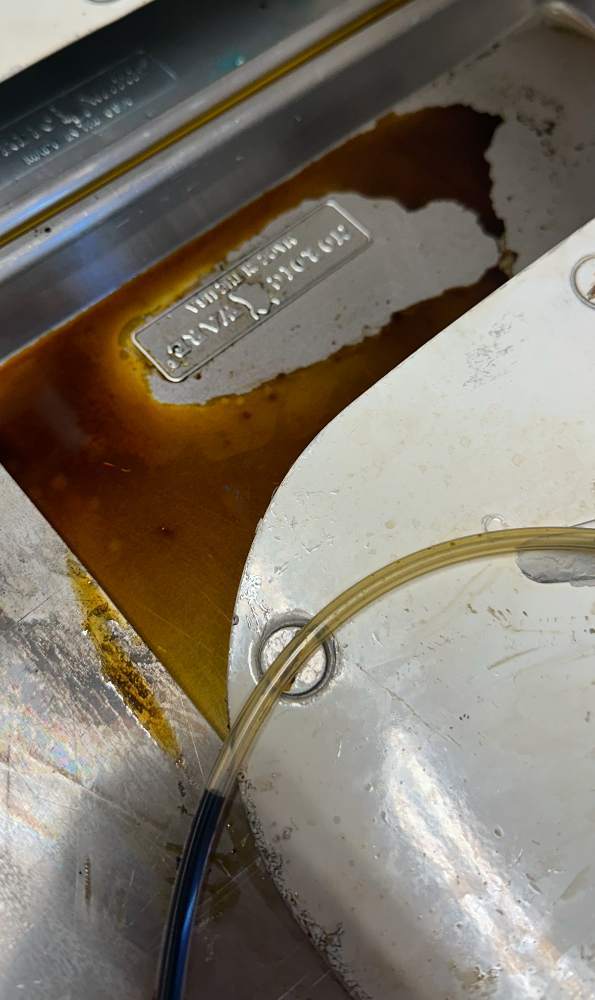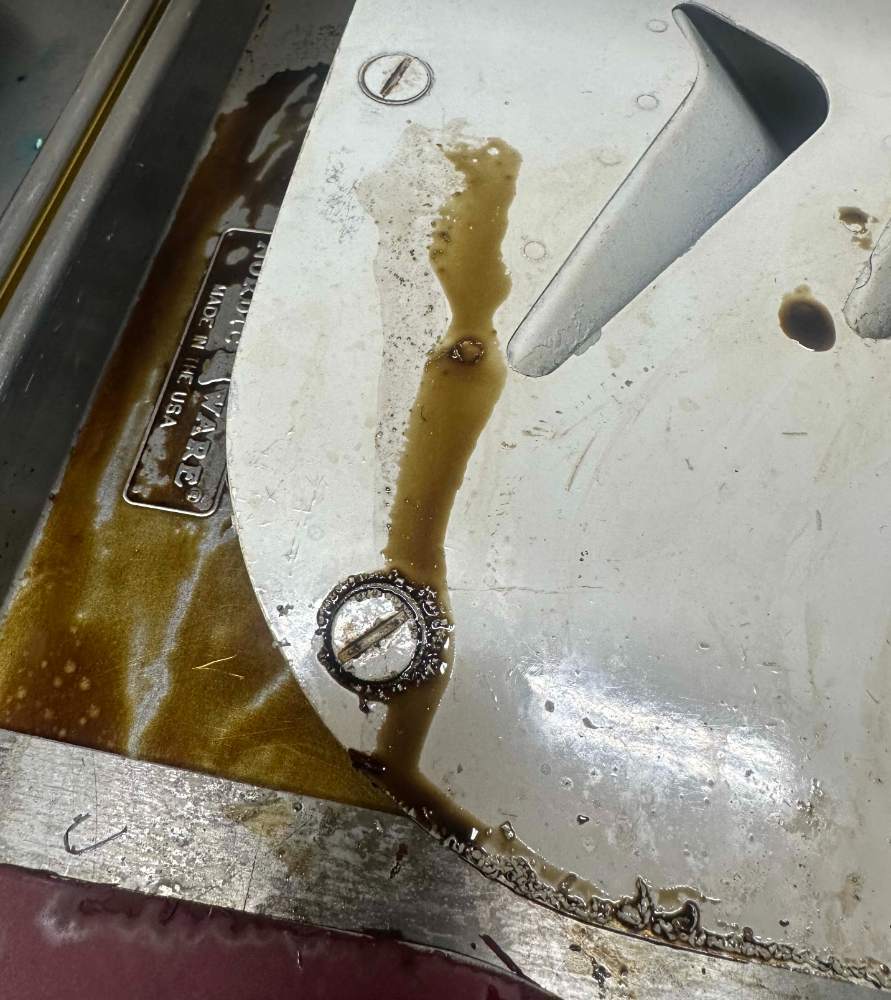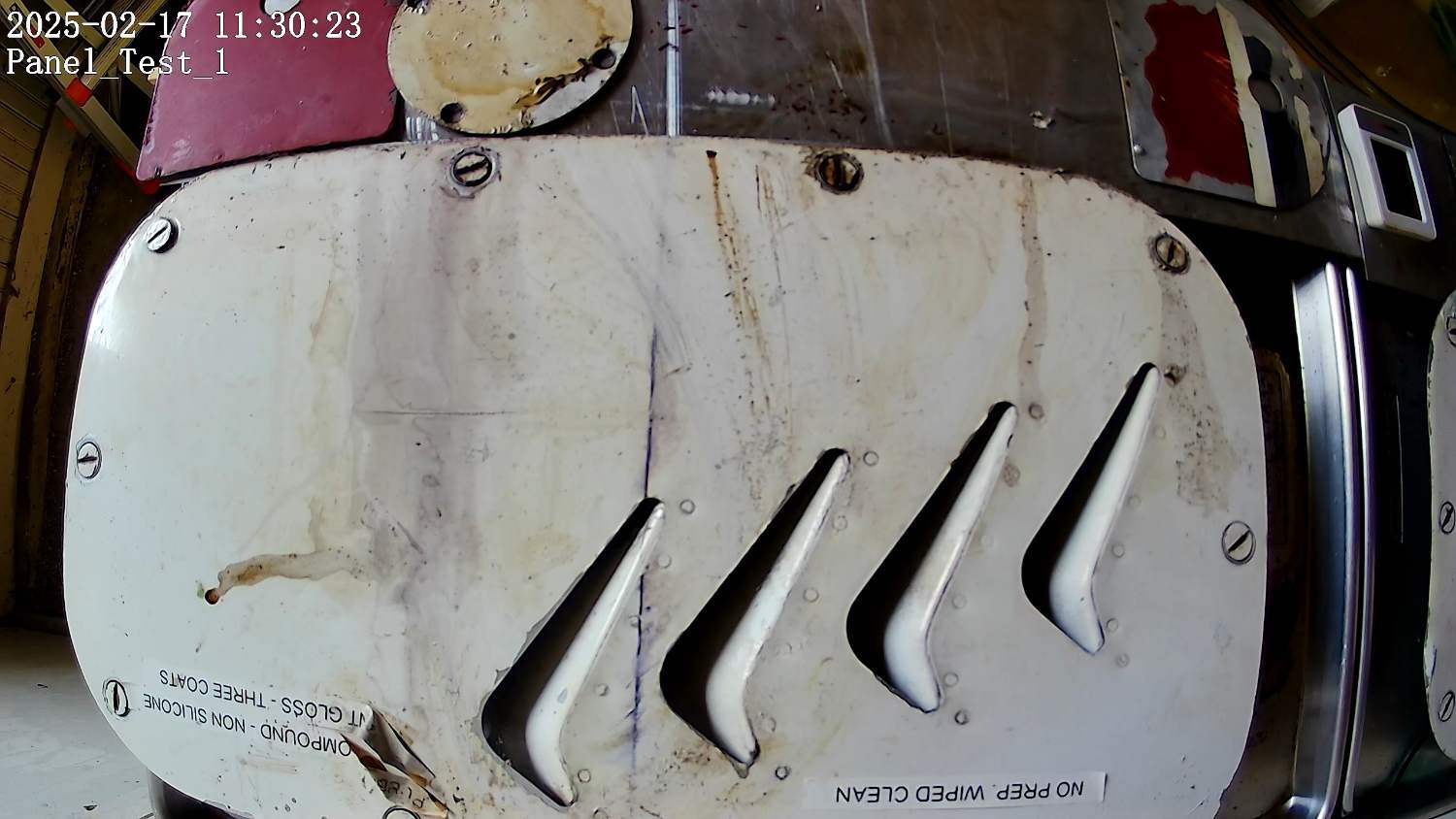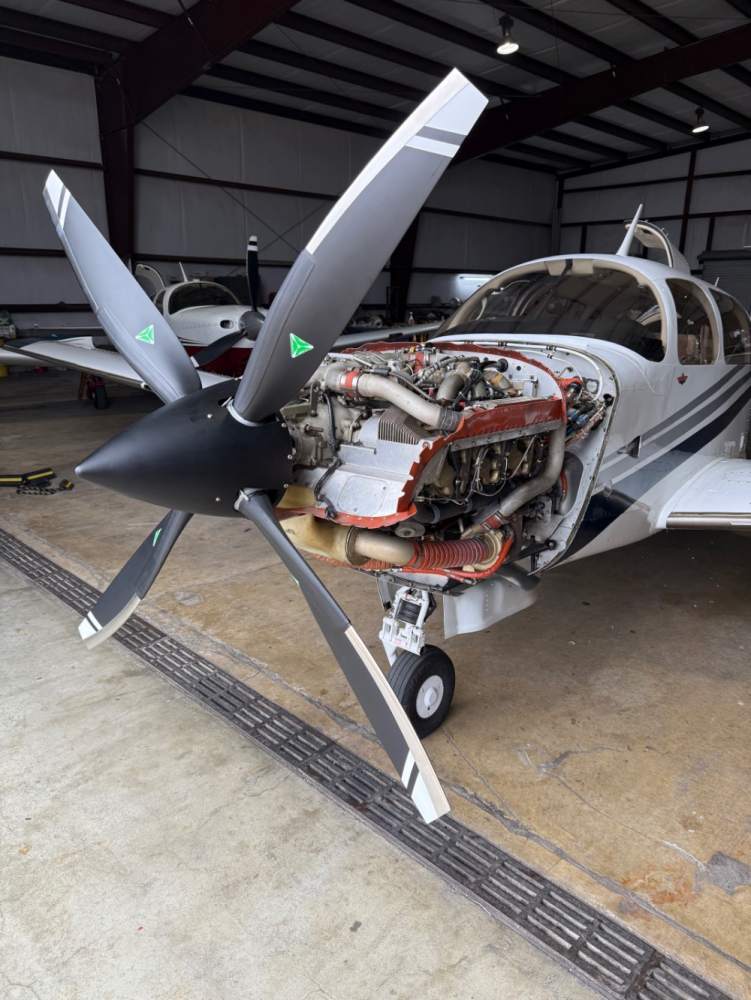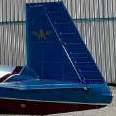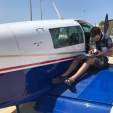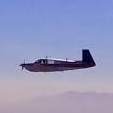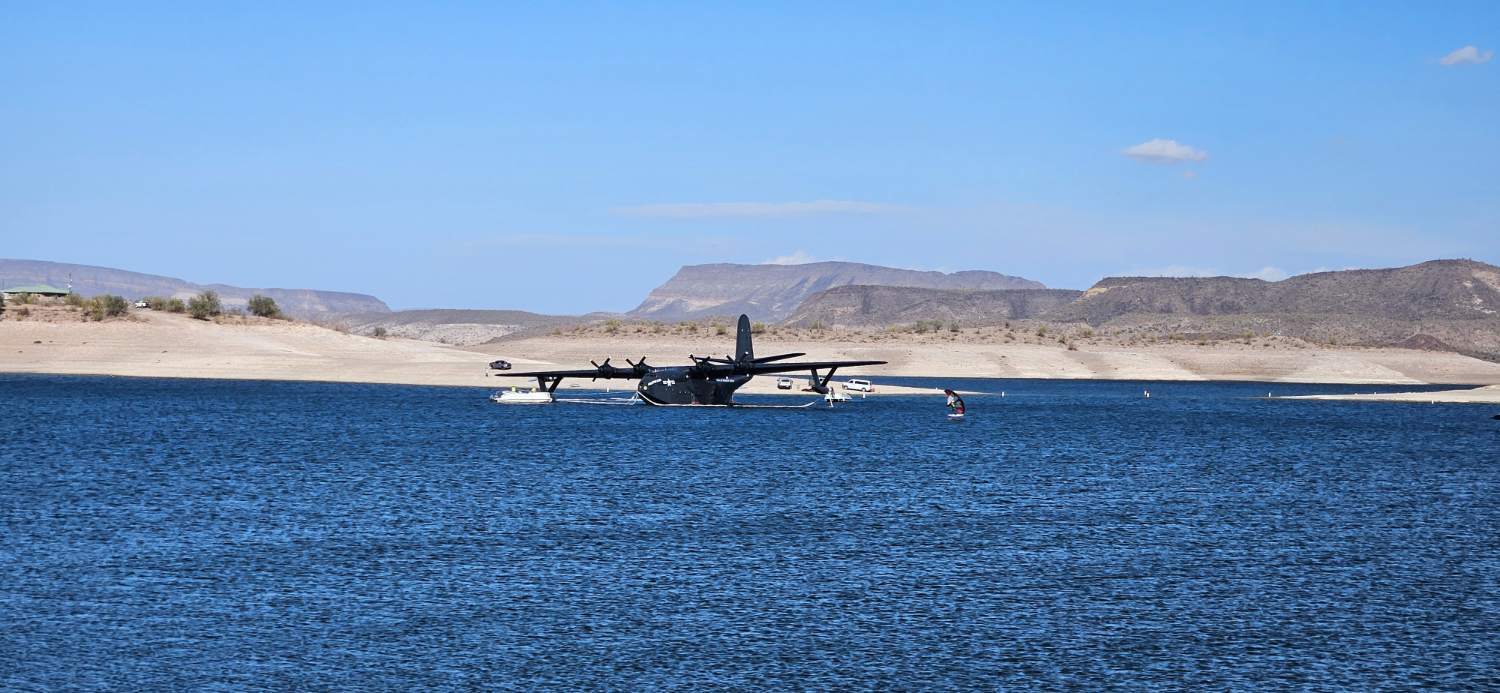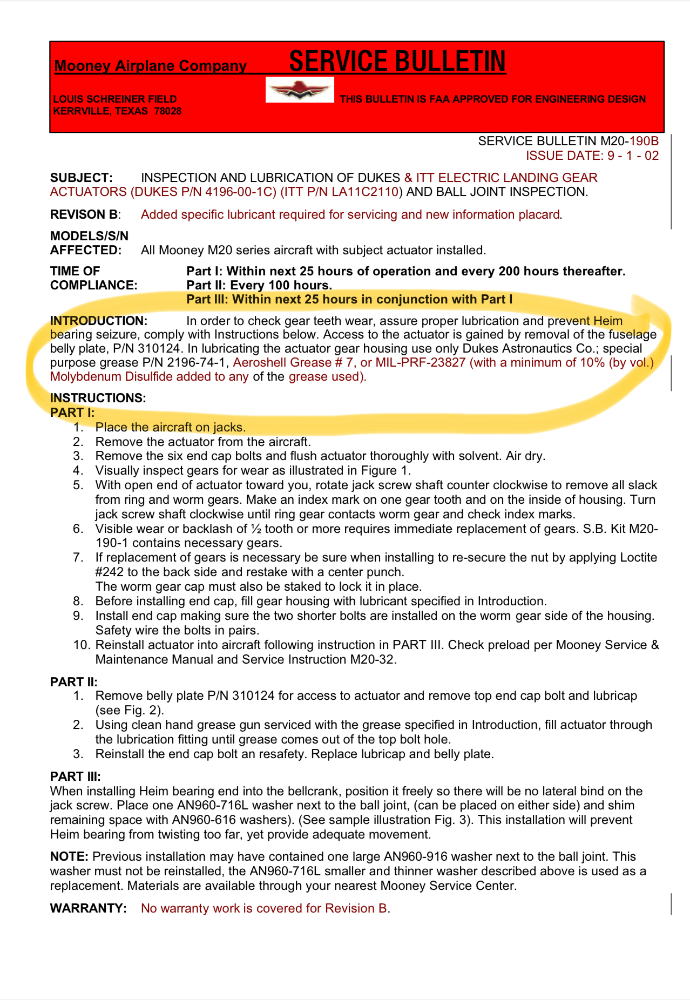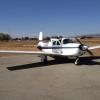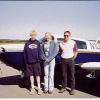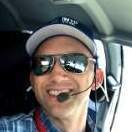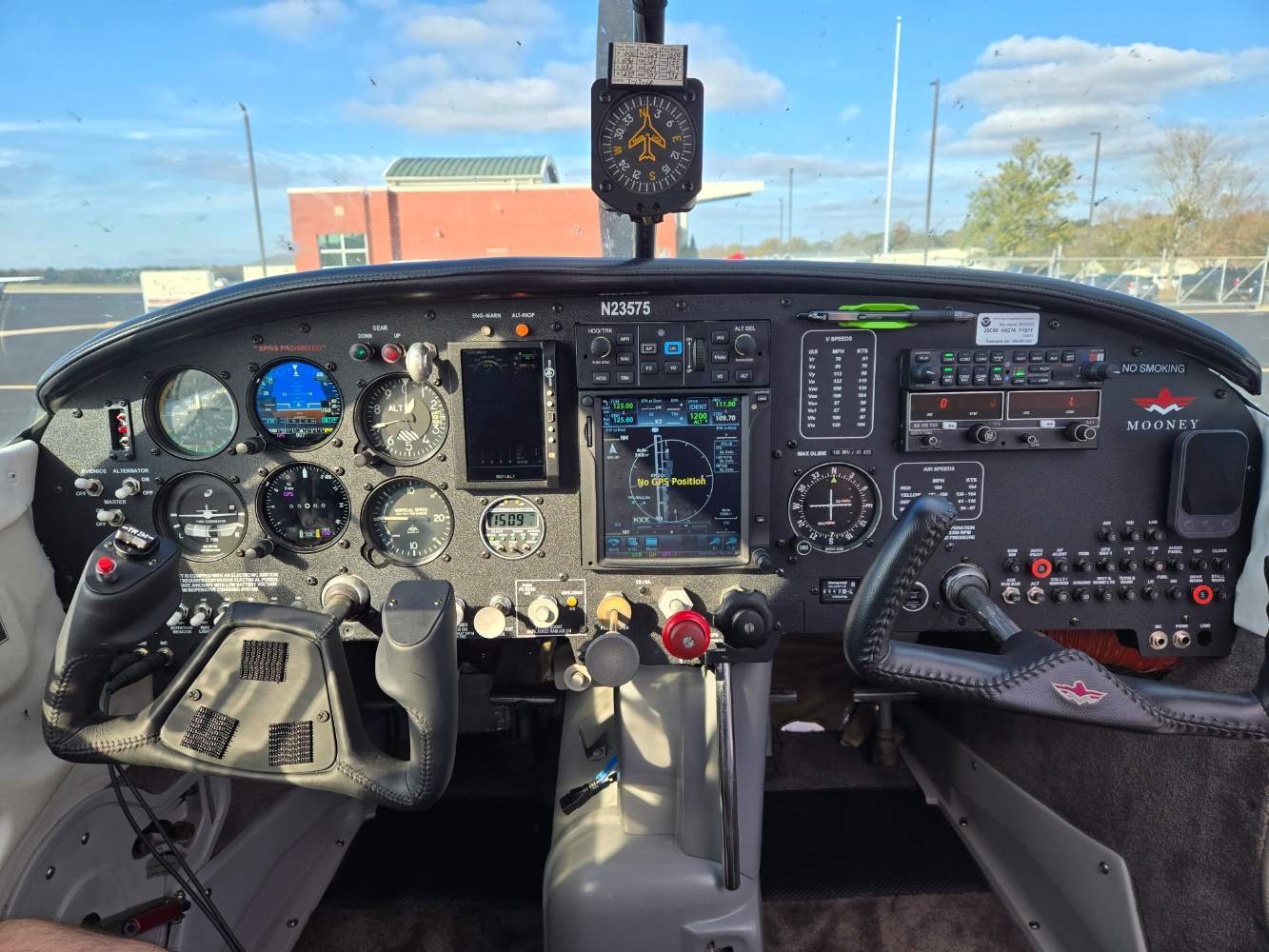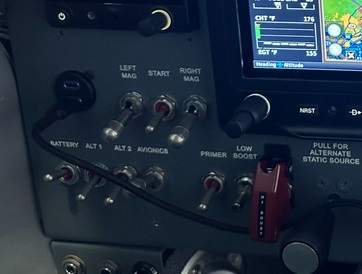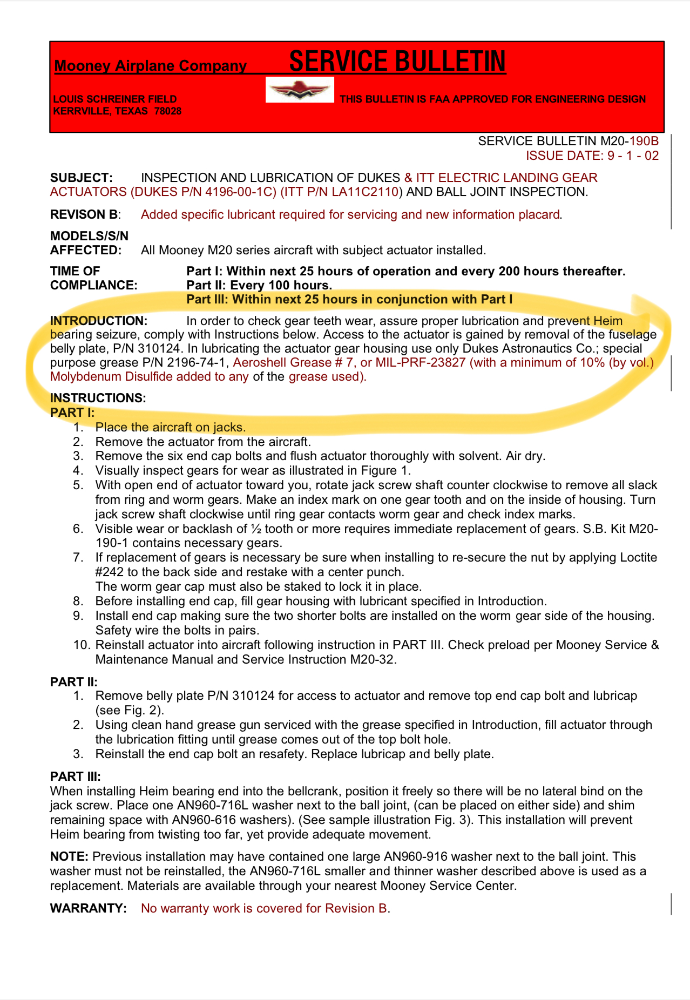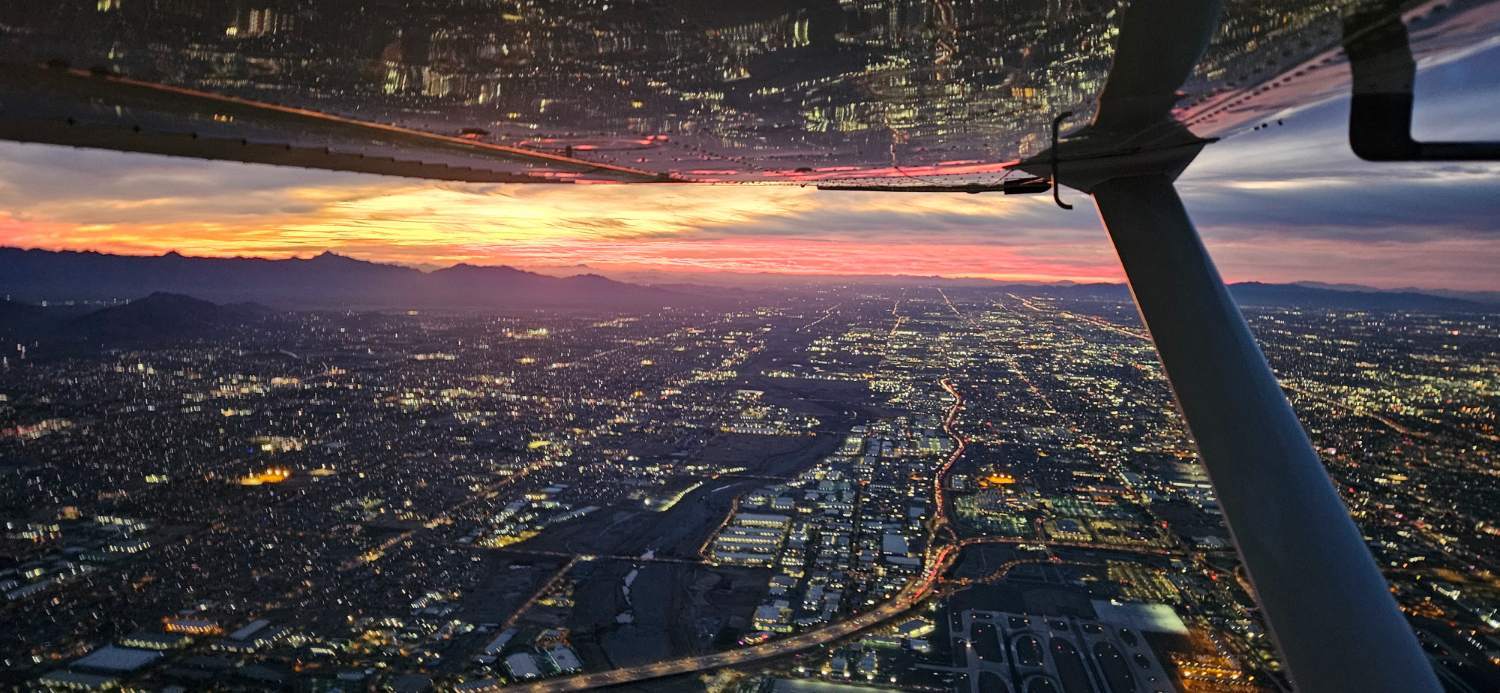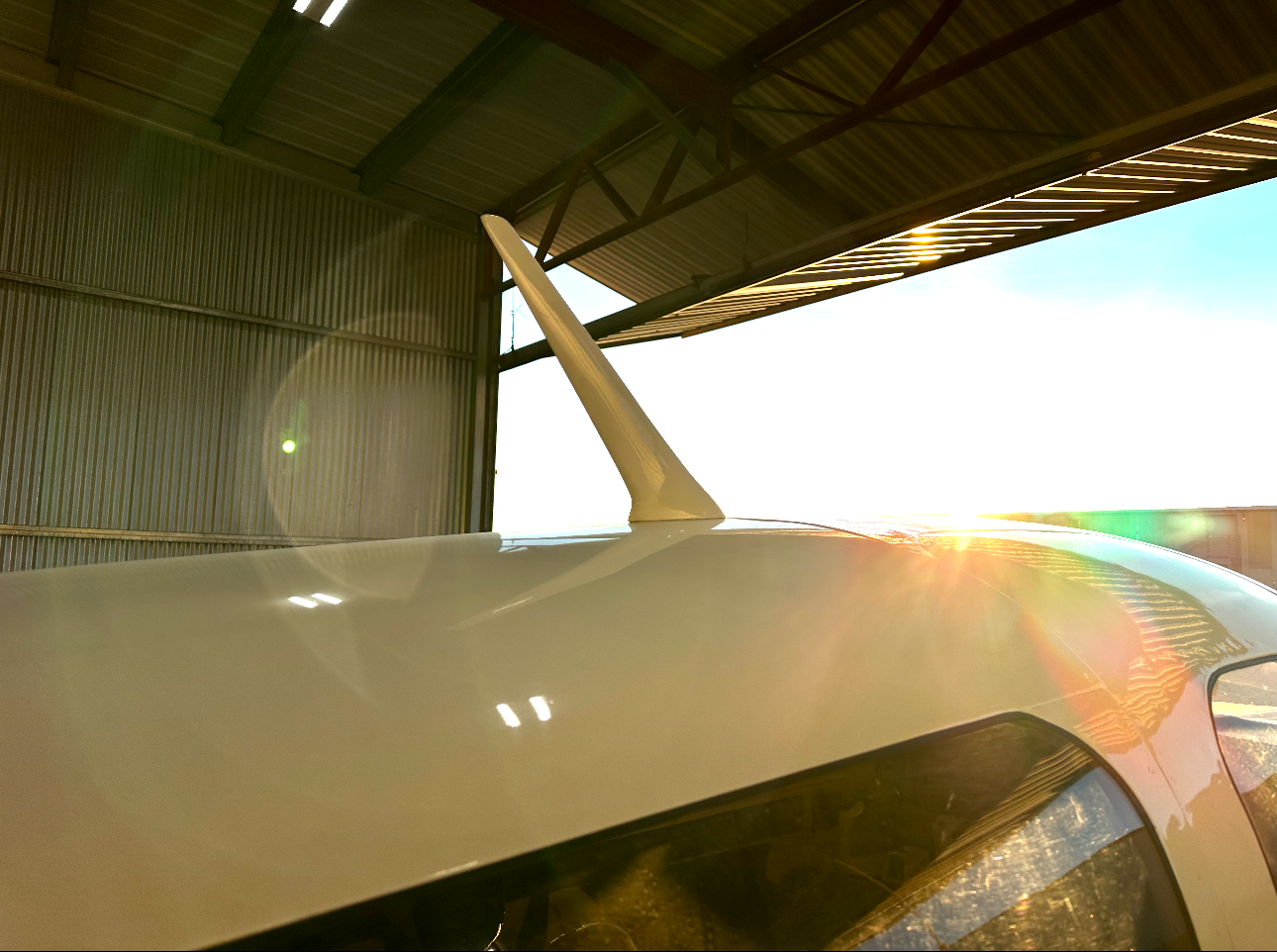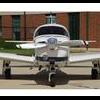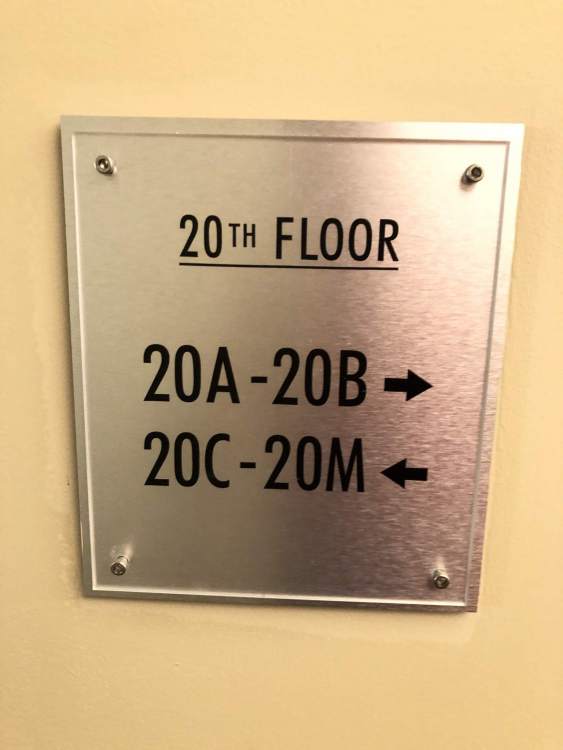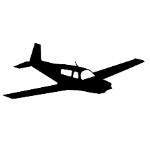Leaderboard
Popular Content
Showing content with the highest reputation on 02/17/2025 in all areas
-
I just got off the phone with Mr. Pollack (Mooney CEO) there IS an agreement that will allow for the manufacture of the 40:1 Gear Sets that we have been hoping/waiting for. The Authorized POC will be contacting me within the next couple of weeks and I will get the cost and timeline information and share with the group as well as the order process. This is GREAT news and wouldn't have been possible without Mr. Pollack's willingness to put in the (unpaid) effort to make this possible. I appreciate everyone patience and encouragement during the process that got us to this point. More to follow once I get more information. V/r Matt14 points
-
I had a conversation with Mooney engineering a few years ago about a patch to an elevator Their emphatic comment was? "We do not approve of any patches to flight controls." Finding a LEGAL way to patch it will be your hurdle. I once looked at that very rudder trim system and wondered how one would ever get the rudder into correct balance when installed. Having balanced a few Mooney rudders I'm still wondering, considering the big tab at the full aft end I don't think its possible. JMO Using a TM 55 as @sabrenech says above has interesting possibilities If it was me I'd just replace the rudder and be done with it. Better resale also! Buyers don't like patches4 points
-
A couple of things about ADS-B weather that I've noticed: 1. Unless you are at an airport that has a ADS-B ground station, you can't get the weather until airborne. This isn't an issue for me because I like the weather depiction on my iPad with Foreflight better than the Garmin equipment and Foreflight will cache the weather data from the internet and then switch to ADS-B once it's available. 2. Be mindful of the ADS-B look ahead ranges because if you zoom way out there may not be data available and radar loses resolution as you zoom out. 3. I have found that it sometimes takes a long time for the graphical TFRs to show up. I always get them from Foreflight connected to the internet before launching as I don't trust ADS-B to show them all. Skip3 points
-
THIS for me as well. Many years ago, I did a C172 checkout for a 20,000 hour retired airline pilot. When we got to the simulated engine failure, he was at best glide and heading toward a landing spot within 6 seconds. Once I realized what he was doing, I started to test it out with other airplanes. All he did was look out the window and pitch for the most familiar attitude - level cruise. Turned out that a level cruise attitude resulted in a speed close enough to best glide that the difference was inconsequential. So inconsequential that trying to be perfect has a negative impact. Even seems to account for weight. I’ve been using and teaching it ever since. I used that technique recently in an “impossible turn” demo. It wasn’t in a Mooney, but I’m linking it below anyway. Tweak if you need to with a touch of trim. If your autopilot has an IAS mode, use it. But only once underway to your landing area.3 points
-
3 points
-
^^^. THIS. ^^^ I figure both back pockets are going to be touching each other if I have an engine failure...No way I'm risking any more of a helmet fire by trying to optimize glide speed based on exact weight and trying to figure out wind speed and direction at several altitudes below me. I've got Foreflight set to 10:1. My biggest fear is going for an airport close to the edge of the glide ring vs. accepting a for-certain makeable off-field site.3 points
-
I recently went to cx my xm, and they gave me 6 months for $79, after I told them I couldn’t even afford $10 a month..2 points
-
Here's how I would summarize: Some paints are more resistant on the surface. The Beech panels I tested (of unknown origin) seemed to be tough, along with Randolph Ranthane and JetGlo. However, I think most issues are from fuel getting underneath the paint and causing failures. It happens at seams, cracks, or if leaks occur inside and weep out, such as the Cirrus, Gabe's Mooney, the two Cessna 421's,etc. I don't see this happening with 100LL. And as noted, I'm pretty sure it's because the aggressive stuff that interacts with the paint/primer is left behind. For example, it's been about 2 weeks since I shut off the pumps on the Beech panels. This is a shot of the Beech G100UL panel tray from the 10th of Feb. The brown stuff is remnants of G100UL (about 48 oz over a couple weeks) that was applied to the panels. There is no residue other than blue dye in the 100LL tray. After taking the above photo, I poured some of the remnants on the panel and it quickly caused an area near a rivet to start peeling, along with the attachment screw area. That rivet is where the tube runs by in the above shot. Anywhere this residue is left to sit on the paint (on top, edges,etc) is where issues are seen. The following photos were an hour or so later. Below is the overall panel this morning. Anywhere the tube was laid and any fuel resided, is where the paint was most affected. Here's a direct link to the testing of the Beech panels if one has not seen it.2 points
-
I use one on my grease gun. I really like it. There are a couple of zerks in the nose wheel well you cannot use it on, but I bought their accessory kit and the adapters make it easy to do them. The kit is very high quality.2 points
-
That was my thought as well...not sure how you balance putting it on, and wouldn't be surprised if it was closer to balance coming off! @Grant_Waite If you go with rudder replacement, I'd call Beegles/BAS at KGXY in Greeley. (Beegles is the maintenance arm of BAS salvage) https://baspartsales.com/ https://www.beeglesaircraft.com/ They do a lot of sheet metal work and also have a paint shop I believe. I wouldn't be surprised if they could get a salvage rudder off the shelf; clean, repaint, and balance for you; and ship to you for your shop to install. Worth a phone call if you're considering that route.2 points
-
I'll be the contrarian...when I upgraded my panel I put in a SXM 69A so that I could have XM weather on my panel as well as XM music. For context, I have an all glass panel and so can use XM on G500TXi and GTN 750Xi. I've found that XM always bumps up the cost at renewal, so it always requires calling to find out what the best package they are offering (NEVER let XM autorenew!). Usually try to get a 6- or 12-month package to see what the best price break will be. Also if you're planning on being down for a bit (maintenance or just not flying) you can put your subscription on pause so you're not paying for it during that time a simple call lets you choose pause and choose reactivation vs leave it indefinite and have to call back to restart. I usually go with the XM pilot express There are some product difference and in general the radar data is usually more current. The coverage map is different which is important for trips down to Caribbean/Mexico/Canada. The satellite vs ground line of sight reception is different. But there's also overlap with ADS-B/FIS-B. If you're a VFR only pilot and usually have short flights around your local area, FIS-b is great. I don't think that XM is orders of magnitudes better, but there are a couple of times that XM feed worked/works better for me. Given weather is a GA pilot equalizer, it's nice to have a little more enhanced and timely product. But as anyone will tell you, neither products are useful for navigating storm cells and aren't near the same as in flight radar. Sometimes 2 is1, 1 is none...meaning it's nice when I need it to have a back up. Of course I'm usually doing most of my weather prep on the ground using ForeFlight Imagery and https://aviationweather.gov/ So in flight this is more confirming that things have changed as I expected or moving the same direction and speed as anticipated. Occasionally it encourages me to take a fuel stop...but usually it just confirms that my plan is still GTG. I'm not flying on the ragged edge of weather anyways. https://www.sportys.com/blog/datalink-weather-for-pilots-ads-b-vs-siriusxm/ https://www.siriusxm.com/aviation/packages https://www.siriusxm.com/aviation/siriusxm-ads-b?intcmp=Global Nav_NA_www:aviation:overview_SXMvsADSB For the ADS-b vs XM discussion it's more dependent on HOW you use it and WHERE.2 points
-
Danny, I am based in the Portland area at KHIO. I have owned my Mooney M20K (231) for more than 10 years. I don't have any deice equipment except for a hot prop and a heated Pitot tube yet I fly all year long. There have been days I don't go - mostly because of ice - but most days, I find are doable because the turbo opens up a huge altitude envelope. Heading south from Portland, the bad weather often clears out around Medford or Redding. Sometimes, it doesn't but mostly it does. The Columbia River Gorge is always tricky because it makes its own weather. When things look doable in the Willamette Valley, the gorge might have an icing surprise for you. As Richard Collins used to profess when writing about his fully weatherized P210 in Flying, he didn't do any more trips in his deiced bird than he would have done in one without it. I think that is the best philosophy. Plan wisely, fly most day, but stay home the days where you can't do it safely. As for the Mooney 231. The weak spot is the single alternator. On an IFR bird, two alternators are almost a requirement. I have lost my alternator three times so far and it's no fun when all your equipment is electric. The strong point of the 231s is their relatively higher useful load than some of the other long-body models and the 252. Mine is 1000 pounds even. Not great, but okay for most trips with two people. I have been very happy with my airplane, but I have only owned one airplane. If I had to do it again, I might get a 252 because most came with two alternators and the most advanced installation of the TSIO-360. I might also get a Cessna T182RG because they are really nice and they carry more, are bigger inside, and easier for passengers to get in and out of. Everything I have heard about the 252 makes me think it is the best of the models. Again, the problem with the 252 is the paltry useful load. If you put deicing equipment in it, the useful load just gets worse. The Encore is a newer version of the 252 with a higher useful load and is really sweet and worth getting if you can afford one. Happily, I got a field approval for a second alternator and installed it last year. I really like knowing if my big finicky alternator kicks the bucket - or its weird elastomer bonded drive gear shraps - that I won't lose my instruments. Good Luck, Mooneys are excellent airplanes. I wish people could still buy new ones.2 points
-
PREP Prop has been installed! Unfortunately the wiring harness for the surefly did not arrive so I didn’t get the electronic ignition installed. But there was plenty more to do. In this visit with Brian K we got a good amount done. 1. Installed new prop and spinner. 2. Changed all exterior lighting to LED. 3. Two new magnetos and timing adjusted. 4. Chafe tape on cowling replaced. 5. Rerigged landing gear for door adjustments. 6. Flap actuator adjustment for correct position indications. 7. Bled and changed brake fluid. 8. Changed all landing gear pucks. 9. Installed bob fields inflatable door seal. 10. Changed landing light lenses. I almost wish that I had flown the plane with just the prop and done the door seal later. Both of these items were done for noise reduction, and both appear to have made a significant difference. The flight back from Texas was almost 5 decibels quieter which is an enormous improvement. the prop on the ground sounds really different, but the noise in cruise is extremely quiet. The prop response is much quicker and while the advertised weight savings of 28# is a flat out lie, there was an actual 18# weight saving which makes a pretty big difference in landing. I also notice that the elevator is about 1/2” less deflection in cruise and it appears to be about 3kts faster in cruise. The lower cowling is a little more difficult to remove and replace, but still easier than an ovation, and I can still do it alone. The TKS slinger ring is also a MUCH design than the hartzell and works much better. I am very happy with the prop and am thoroughly enjoying the restoration process. I will make a separate post regarding the door seal install, for any of those interested in installing. I believe after doing one, I could do it over again in less than 3 hours. It is incredibly simple once you know the shortcuts. Coming items…. updated fuel caps to new style. surefly mag install. new glass all the way around. New interior reseal of tanks new landing gear doors on right side. brake system overhaul. new paint. pending/contemplating type S conversion. corrosion X treatment. motor mounts. new panel cutout to install 275 in center and push mfd over. earthX batteries2 points
-
Well it’s the new year and I thought I’d start the thread for this calendar year. Hope is for lots of flights throughout the year. Bonal1 point
-
I would have taken that deal ($79 for 6). But I kind of get tired of the games and I’ll forget to call and cancel. If they can afford to retain me at that rate, just offer that rate for goodness sake. I feel thats about what I’d pay for the service.1 point
-
I keep the basic XM subscription (list price $29) and an xm audio infotainment subscription. For a long trip XM shows a nice nexrad radar picture across the country - much better than the blocks of farther out ADSB. In the grand scheme $29/mo. isn't even a rounding error on my aviation expenses. Sirius XM plans: https://www.siriusxm.com/aviation/packages?intcmp=Global Nav_NA_www:aviation:plans_Plans Legacy XM plans: https://www.siriusxm.com/content/dam/sxm-com/pdf/aviation/XMWX_Aviation.pdf Differences between SXM and ADS-B: https://www.siriusxm.com/aviation/siriusxm-ads-b?intcmp=Global Nav_NA_www:aviation:plans_SXMvsADSB1 point
-
This seems to suggest the hypothesis that it may be the low volatility compounds that concentrate and contribute to longer dwell time and more risk. But it also makes me wonder what happens in separate Aux tanks that aren’t used frequently or the fuel tank sealant that is up top of the tank that gets wetted but not typically soaked with fuel. Leaks aren’t the only time fuel components get wetted and then allowed the dry and concentrate.1 point
-
You may want to sign up for a PPP then, especially if the plane is new to you. Or even if you've had it for years. You'll get the ground school to go along with the manual you thought was pretty amazing and all the people there to ask follow up questions. Then the flying will be with someone that knows your model and you can work on things you know you need to work on, or let them just show you some tips and run you through the basics. You'll also walk.. er.. fly away with an IPC and Flight Review. So you get those checked off too.1 point
-
Why? I own a Mooney that does NOT need to be repainted.1 point
-
One big difference is the higher resolution of SXM out past 200 mile range. I have both. https://ipadpilotnews.com/2020/07/ads-b-weather-vs-siriusxm-satellite-weather-comparing-the-options/ https://www.cessnaflyer.org/magazine/article-archives/avionics/ads-b-vs-siriusxm.html https://siriusxmcommunications.com/sxmaviation/daretocompare.html https://www.aopa.org/about/aopa-partners/siriusxm-aviation/infographic1 point
-
It works but it's too long to get onto all the zerks on my plane.1 point
-
If no circuit breaker pops, it is either the down relay or the down limit switch. The switch is sealed so you can't get contact cleaner to the contacts, but sometimes the plunger gets gummed up and sticks so spraying the plunger with contact cleaner might free it up. With the airplane on jacks and the gear up, you can spray and then exercise the down limit plunger several times. For good measure, you can do the same to the up limit switch with the gear down. If the down limit switch is bad and it is 1CH116-6 that switch is obsolete and the replacement is a 1CH1-6. Edit: Also might be the gear switch on the panel.1 point
-
I've cleaned the fuel screen before. I remember seeing it and know it's out of date (not that it's any indication under our regs because we replace on condition). I'll go over at lunch and drop the panel and find out what it is. I like the price at Aero Motors a lot better than Aircraft specialty but Tulsa is a lot closer to me and I have access to another plane to just pop up there and exchange it. ($550 vs $1250). It made the sound that it was pumping but it acted like it had air in it and surging. I may take a video when I go take the panel off. My fuel pressure gauge goes from 0 to 30. The green arc is 14-30. When I turned the pump on it bounced between about "shivered" around 5-6 PSI and jumped to 10 PSI and then bounced back between 5 and 6.1 point
-
Those zerks get pulled out when a too tight fitting is used on the grease gun and the mechanic just yanks the hose off with a little side motion. I use an adjustable tension fitting on my grease gun They are a press in and IIRC a deep 1/4" socket on an extension will help to set them with a small hammer Also they ae called "ZERK" fitting after their inventor Oscar Zerk who invented them in 19291 point
-
1 point
-
Understand, and my opinion is neither should be used to save your life. Just a macro and an ability to bring up the latest WX at your destination prior to getting the recorded atis1 point
-
1 point
-
It is a MAPA PPP, hence the title. What curriculum did you see that was generic. Typically Friday is the Ground School day and you fly on Saturday. Sunday is a rain day or if there are a lot of attendees I think some get moved to Sunday morning. Then departure. And I'm assuming you got the manual by attending a PPP, so it basically runs the same way.1 point
-
1 point
-
Glide ratio and one glide speed are entered in config mode. There is no adjustment for weight. But after Smart Glide activates the GFC 500 in IAS mode, you can adjust the airspeed up or down with the thumbwheel.1 point
-
Best glide ratio does not change with weight, it's pure geometry: the B747, PC12, P51 have some nice glide ratios yet they are "pretty heavy" The propeller has lot of effect, I would say between 1:10-1:13 in M20J, however, I am damn sure it will not work if an engine fails unless I forgot to put Avgas Best glide speed Vbg increase with weight (like stall speed increment but one need to whole polar curve) and headwinds (decrease with tailwind), in thoery, one should calculate vertical speed (fpm) to ground speed (kts), then find indicated airspeed that maximise the ratio. I have done hundreds of hours optimising glides in Astir and Discus, none of that was relevant when engine quit in C172, I just glanced at iPad for my options, put it at 80kts and started looking outside. It's mostly about having a speed I mind and doing some planning, what matters is where your aiming point or selected field moves with respect to the horizon and the aircraft, if it goes up you won't make it, if it goes down you will make it, this applies irrespective of calculations In M20J, I plan to fly 90kias and plan 1:10 to arrive at 2000ft overhead my landing spot On a side note, I wonder what numbers go into "smart glide" by GTN?1 point
-
1 point
-
1 point
-
1 point
-
Ray it is badass, I’d love to know the difference the four blade makes, you’ll end up with the nastiest Acclaim around. It’ll look fast just sitting on the ramp. We need a turbo or all Mooney flyin somewhere some weekend. Be cool to see 40-50 badass planes sitting together.1 point
-
That is a very interesting idea to which you allude with the panel: Replacing backups with a GI-275 in the center. It's funny I always hear about the STC limitation with the G1000 but I rarely hear about big panel mods. Someone theorized that you might be able to cross feed data between the 275 and the G1000, and get better communication with other Garmin devices that way. (I know Lance is looking at a more direct flightstream based mod right now...) You could also drop a second unit in HSI mode underneath and get a more full featured backup set... You also probably know this, but if you put in a Garmin USB plug you can also use that for updates. Looks like it's shaping up as a really custom plane. Vaguely envious of your slight aft CG.1 point
-
1 point
-
337 Is required as any repair to a flight control is a Major repair. As well as one for removing the STC’d. I don’t think the SRM has any repairs to Flight controls allowed. I would look for a new rudder or leave it alone. -Matt1 point
-
@Skates97 OMG !! Where do you land if you lose an engine in an area like that?? Love my rural U.P. of Michigan Tom1 point
-
1 point
-
If you are looking for an excellent Avionics Installer you need to consider Eduardo Perez out of KGMU, he has excellent pricing, impeccable workmanship and a really nice guy...My first experience with an avionics upgrade and I'll never take my plane(s) to anyone else...great communication throughout the process, no suprise pricing and it was started/completed when he said it would be, also an A&P (IA) and pilot... give him a call at 864-790-04111 point
-
1 point
-
1 point
-
1 point
-
1 point
-
1 point
-
First, for a 2 person IFR traveling single engine piston, a Mooney can’t be beat. For terrain and weather climbing ability a turbo Money is pretty awesome. For a lot of us, the M20K 252/Encore is the sweet spot in terms of speed and fuel efficiency. A Bravo, Acclaim, or Rocket conversion is faster but not necessarily better useful load especially when you factor in more fuel burn. A TKS Mooney can also increase your dispatch rate and may get you through a layer but none of the single engine pistons are true ice machines so should be flown in ice with caution regardless if FIKI certified. From a useful load perspective, the 252 Encore conversion is a sweet spot given 3130 max gross but a little lighter empty weight than the factory Encore that had better insulation, interior and cosmetics overall. For me, the M20K Encore is my jam. Next step up for me would come with an extra $1M or so buy-in.1 point
-
1 point
-
Being based on the Gulf Coast my heater rarely gets used but it's always functioned well. In fact I can't imagine how anybody could ever need more hot air than this thing pumps out when fully open; it is overwhelming at any temperature above freezing. Even with the "cabin vent" fully open it only takes a small amount of "cabin heat" to warm things up when south of the Mason-Dixon line. And then... On my recent trip into Colorado I penetrated a cold-air mass enroute that had me grasping for the "cabin heat" knob only to find that it was stuck firmly shut. I pulled harder and harder but didn't want to break anything. Particularly I didn't want to pull it wide-open and be unable to close it again. Eventually I managed to feel a little "give" in the knob/cable and started feeling some warm air flowing from the vent. After getting just enough air to stay comfortable I left it alone for the duration of my trip modulating the temperature by opening and closing the "cabin vent" instead (and stayed plenty warm). So you ask "where's this going CNOE?" Here... I finally got a chance to investigate the issue and wanted to share my findings/observations to aid others who may need to service their own plane with this issue. On my J ('78) the heater control valve is a very simple flapper-type valve located on the right firewall. It resides inside the oddly-shaped box where the scat-hose connects between the exhaust muff and the firewall. Servicing it was quite straightforward but I'll remove a bit of the mystery about what's inside this box. I apologize for not taking more pictures. In order to lubricate the flapper-valve assembly, spring (yes, spring), and heater-control-cable you should remove the outer box (shroud) for complete access to the inner workings. It's also advantageous to have the cable completely free in order to properly lubricate it. To do this first remove the scat hose from the box and tuck it out of the way. Next, loosen the control cable nuts and slide both the nuts and washers from the threaded sleeve (this will allow you to clean up the threads completely before re-installation). You'll also need to remove the retainer screw that clamps onto the cable. If your cable is curled into a "U" at the end as mine was don't fret; there's an easy way to remove it from the retainer nut. To do this simply position the retainer/are as far to the end of the cable as you can and then wiggle-and-rotate the retainer so that the hole slowly makes its way around the cable's U-shaped end. It's not obvious upon first-look but as you spin/turn the retainer it will allow you to remove the cable entirely. Once that's free you can slide the cable out of the attachment and move it out of the way. Now all you have to do is remove the shroud from the assembly (which will remain fixed to the firewall). The shroud is connected to the valve-assembly by four machine screws (essentially one at each corner). These are not the four screws attached to the firewall (see photo). Oddly 3 of the 4 screws were secured into fixed nut-plates on the back of the valve's outer flange, but the remaining screw (on the lower right side) passed through the flange and was secured with a free-floating locknut. This nut required a 11/32" backup wrench for removal and this was complicated in my application by the adjacent Oil-Separator (which thankfully I did not have to remove). Also note that this lower-right screw is slightly up/under the angled deflector (see photo) so you cannot get directly inline with your #2 phillips screwdriver. Make sure that your screwdriver tip is in good shape or you may have trouble removing this screw at the small angle required. The other 3 screws are fairly easy to remove. All 4 screws have a flat-washer under their phillips heads. Once the screws are out the shroud slides straight forward and off of the flapper-valve. The valve is a simple square flat plate attached with a long shaft through 2 pivot points. You'll also find a small pivot spring on the shaft that is designed to keep the valve fully closed when not held open by the control cable. The plate seats against a robust tubular structure passing through the firewall. There isn't a rubber seal or similar but the flapper (plate) has a circular bead of hardened sealant on its surface that mates with the adjacent tube (do not remove/clean this material). Lubricate this entire assembly generously while swinging the flapper plate open and closed repeatedly. I would also recommend brushing/moving the spring independently of the flapper to clean it up as well. You may also want to use a brass brush or similar to gently clean the entire assembly. Oh yeah, don't forget to put a rag under the area before doing all this, and a shop vac comes in handy as well. Once the valve is cleaned up and thoroughly lubricated it should easily swing open and closed with the spring capable of closing it on its own. Next is the cable lubrication step. I don't have any fancy methods of doing this so I simply wrap a rag around the end of the cable sheath and start pumping oil into the end while an assistant repeatedly moves the cable knob in and out from the cockpit. Also have the assistant put some oil on the control rod in the cabin. Once you get some lubricant inside the cable sheath it should start moving easily. Now all there's left to do is re-assemble everything just the opposite of how you removed it. Putting the screws back in place was easier than I expected though starting the one locknut took a bit of patience. Also, don't forget to put the cable-nuts in place before you re-install the retainer at the end. When it's all back together make sure that everything is moving smoothly and adjust the nuts in/out so the the valve is fully closed with the control knob not-quite all the way in (you want to leave just a little "push") like on the other controls. That's it! There's nothing too difficult about it and those of you with good mechanical skills will scoff at the need for this write-up. But if it helps anybody de-mystify things then my time writing it wasn't wasted.1 point

